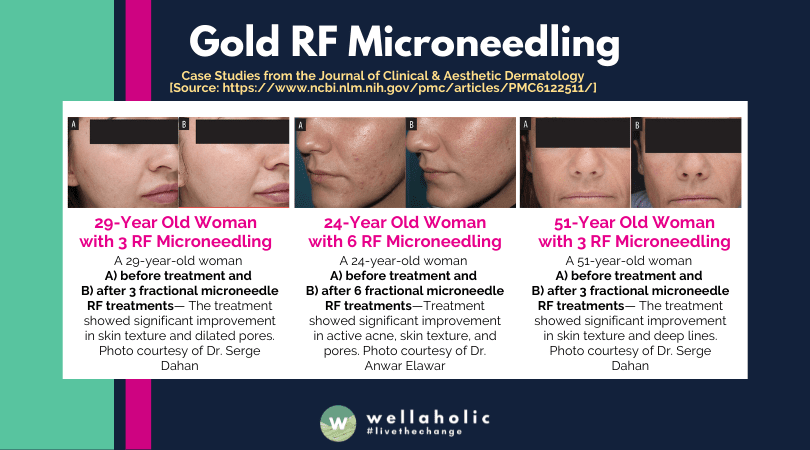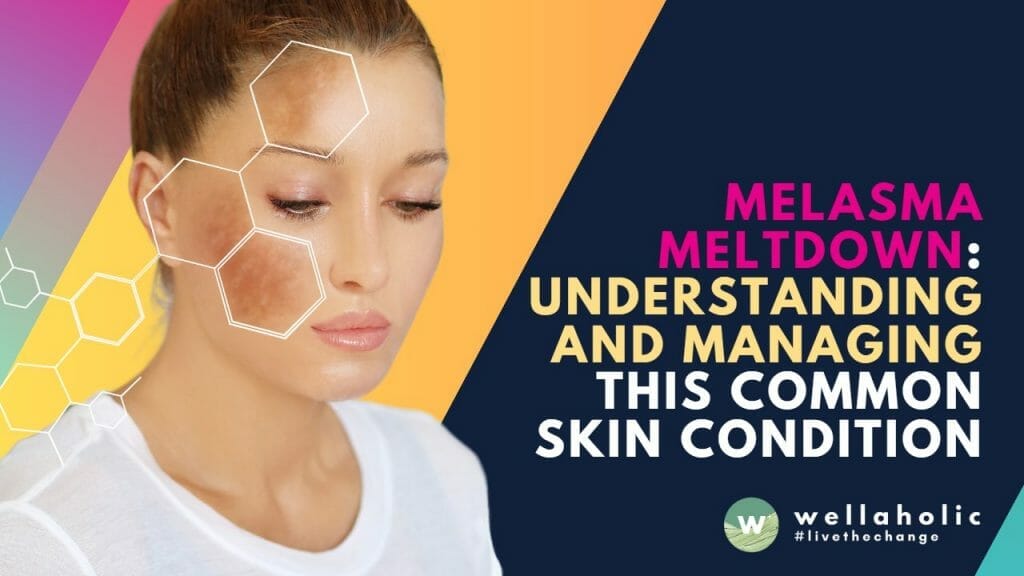
Melasma Meltdown: Understanding and Managing This Common Skin Condition
Table of Contents
- 0.1 TL:DR Summary
- 0.2 Welcome to the “Melasma Meltdown”
- 0.3 What Exactly is Melasma?
- 0.4 What are the Causes of Melasma?
- 0.5 What are the Symptoms of Melasma?
- 0.6 What are the Treatments for Melasma?
- 0.7 What Lifestyle Changes Can You Adopt to Prevent Melasma?
- 0.8 Microneedling Can be Effective in Treating Melasma
- 0.9 Reasons to Why RF Microneedling is Becoming Increasingly Popular
- 0.10 Conclusion
- 0.11 Frequently Asked Questions (FAQ)
- 0.12 Book Now Pay Later
- 0.13 Gold RF Microneedling Facial
- 1 Mastering Melasma: Understanding, Treatment, and Management Tips for Clearer Skin in Singapore
TL:DR Summary
- Understanding Melasma: Melasma is a common skin condition causing brown patches, often triggered by hormonal changes and sun exposure.
- Melasma Risk Factors: Pregnant women, those on hormonal treatments, or people with darker skin types are more susceptible.
- Prevention Strategies: Regular use of broad-spectrum sunscreen and avoiding sun exposure can help prevent melasma.
- Topical Treatments: Topical creams with hydroquinone, tretinoin, and corticosteroids can lighten melasma but require careful use.
- Professional Treatments: Laser therapy, chemical peels, and microdermabrasion offer more intensive options for melasma management.
- Personalized Treatment Plan: Always consult with a dermatologist to create an effective, personalized melasma treatment plan.
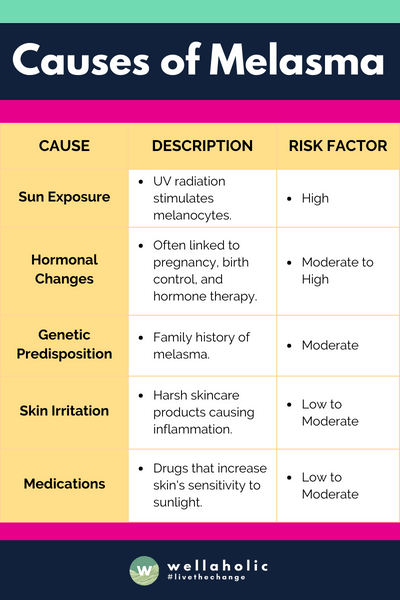
Welcome to the “Melasma Meltdown”
In my years in the aesthetics field, I’ve met many clients dealing with melasma. It’s a common skin issue that can really affect someone’s confidence. Melasma shows up as dark patches on the skin. It’s more than just a cosmetic concern; it’s a complex condition that reflects our skin’s health and its reactions to various factors.
Understanding melasma is the first step to managing it. I’ve learned a lot through my work and research. I’ve seen how sun exposure, hormonal changes, and even stress can trigger it.
In the article that follows, I’ll share more about what I’ve found. We’ll look into why melasma happens and how we can handle it. My goal is to give you clear, simple advice. This way, you can feel more in control of your skin’s health.
“Take control of your skin and harness the power of positivity to get through melasma!”

What Exactly is Melasma?
What is Melasma and What Causes It?
Melasma is a skin challenge I often see among clients at Wellaholic. It shows up as brown or grayish-brown patches, usually on the face. Though it’s famously linked to pregnancy, earning it the nickname “the mask of pregnancy,” it doesn’t discriminate. Men and women alike, across all ages and skin types, can find themselves dealing with melasma.
The root cause of melasma remains somewhat of a mystery, but we’ve noticed a few common triggers. Hormonal changes are a big one, especially those related to pregnancy or certain medications. Sun exposure can make it worse, and there seems to be a genetic component too. Understanding these triggers is key to managing this condition.
How Does Melasma Affect Your Well-Being?
Melasma isn’t harmful, but it often leads to self-consciousness and anxiety. Many feel embarrassed or down about their looks, avoiding social events or sun exposure. It can hit your self-esteem hard, particularly in jobs needing a polished appearance.
How Can You Treat and Prevent Melasma?
If you’re tackling melasma, your options range from topical meds and chemical peels to laser therapy. Key lifestyle tweaks, like dodging the sun and slathering on sunscreen, also play a big part. The right fix varies with your skin type, how severe your melasma is, and what you prefer. You might need to test out a few different treatments to hit upon the one that really does the trick for you.
To keep melasma at bay, daily sun protection is key. Make sure to use a broad-spectrum sunscreen with at least SPF 30. Reapply it every two hours, especially after sweating or swimming. Don’t forget to wear a hat and sunglasses, and stay in the shade as much as you can. Also, be cautious with hormonal medications like birth control pills or hormone replacement therapy. They can trigger melasma. Only use them if your doctor says they’re necessary for your health. If you’re pregnant or planning a pregnancy, talk to your doctor. They can guide you on managing melasma during and after your pregnancy.

What are the Causes of Melasma?
Dealing with melasma has been a significant part of my work at Wellaholic, as part of my consultation to customers. The exact causes of melasma can be elusive, but we’ve identified a few usual suspects. Hormonal changes often play a big role. For many women, pregnancy brings about not just joy but also the “mask of pregnancy,” as melasma is sometimes known. It’s similar with birth control pills and hormone therapy, which can also trigger melasma.
Factors Contributing to Melasma: Sun Exposure, Genetics, and Melanin Production
Sun exposure is another major factor. UV rays from the sun can ramp up melanin production, the pigment that colors our skin, causing those telltale dark patches. Lastly, genetics might also have a hand in this, as melasma often runs in families.
What are the Symptoms of Melasma?
In my time at Wellaholic, I’ve seen firsthand how melasma affects our clients. It’s a condition that brings uneven brown or grayish-brown patches to the face, most often on the cheeks, nose, forehead, chin, and upper lip. These patches can also appear on parts of the body that get a lot of sun. While melasma doesn’t hurt, it can really impact how someone feels about their appearance. For some, it fades on its own. Yet, for others, it’s more persistent and requires treatment to improve.
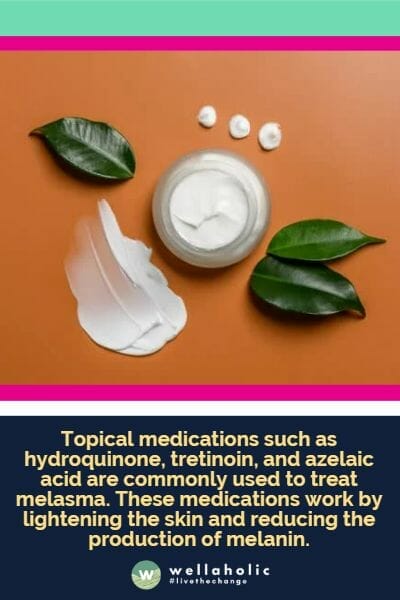
What are the Treatments for Melasma?
Topical medications for melasma
Treating melasma often involves topical medications. These work by lightening the skin and reducing melanin production. Common options include hydroquinone, a bleaching agent; tretinoin, a vitamin A derivative that speeds up skin cell turnover; and azelaic acid, which fights inflammation and fades hyperpigmentation. Typically, you apply these once or twice daily over several weeks or months.
Chemical peels for melasma
For those dealing with melasma, a chemical peel is a viable treatment. In this process, a chemical solution is applied to your skin. It peels away the top layer, unveiling fresh, healthy skin beneath. This method works by shedding damaged skin cells and promoting new collagen growth. Chemical peels come in different strengths and depths. Often, you might need several sessions to see the results you want.
Laser therapy for melasma
Laser therapy offers a treatment option for melasma. It uses a laser to send light pulses that target skin melanin. This process breaks down melanin, helping dark patches fade. Sometimes, laser therapy works better than creams or chemical peels. However, it carries risks like scarring, infection, or skin color changes. Often, several sessions are needed for the best results.
Microdermabrasion for melasma
Microdermabrasion, which involves using a device to exfoliate the skin, may also be used to treat melasma. This can help to remove the top layer of skin and promote the growth of new skin cells.
See the table below on the different treatment types for Melasma:
| Treatment Type | How Can Melasma Be Treated |
|---|---|
| Topical Medications | Creams or gels containing hydroquinone, tretinoin, or azelaic acid are applied to the skin to lighten the patches of melasma. |
| Chemical Peels | A chemical solution is applied to the skin, which causes the top layer to peel off and reveal new, healthy skin underneath. |
| Laser Therapy | A laser is used to target the melanin in the skin, which breaks it down and causes the dark patches to fade. |
| Microneedling | A device with tiny needles is used to create small punctures in the skin, which can stimulate collagen production and improve the appearance of melasma. |
| Sun Protection | Wearing protective clothing, such as hats and long sleeves, and using a broad-spectrum sunscreen with an SPF of at least 30 can help to prevent further damage to the skin. |
It’s important to note that the effectiveness of these treatments can vary depending on the individual and the severity of their melasma.

What Lifestyle Changes Can You Adopt to Prevent Melasma?
Protect your skin from the sun
Excessive sun exposure can trigger melasma, as it ramps up melanin production in your skin. Melanin is responsible for skin color. To prevent melasma, limit your time in the sun. Wear hats, sunglasses, and protective clothing. Always use sunscreen with SPF 30 or higher every day. It’s best to stay inside during peak sun hours, 10 a.m. to 4 p.m., especially in Singapore’s strong sunlight.
Eat a healthy diet and stay hydrated
To combat melasma, focus on a diet rich in vitamins, minerals, and antioxidants. These nutrients shield your skin from damage and inflammation, often leading to melasma. Opt for skin-friendly foods like fruits, vegetables, nuts, seeds, and oily fish. Don’t forget to drink lots of water too. It keeps your skin hydrated and helps eliminate toxins.
Manage your stress levels
Stress can take a toll on your skin, increasing the risk of melasma. When you’re stressed, your body produces more cortisol. This hormone ramps up melanin, which can inflame your skin. To keep melasma at bay, managing stress is key. How? Try regular workouts, yoga, or meditation. Even listening to music or spending time with friends and family can help. Keep it simple and find what works for you.
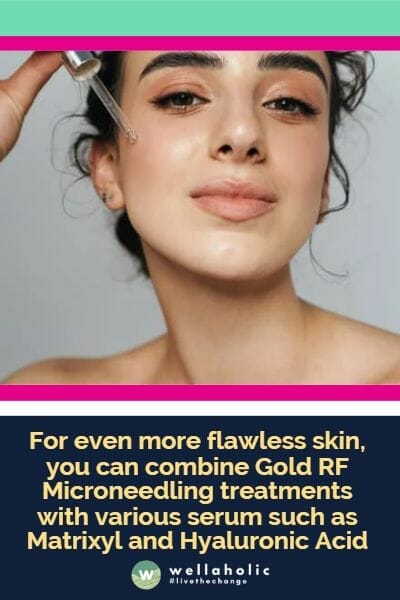
Microneedling Can be Effective in Treating Melasma
What is microneedling?
Microneedling is a cosmetic procedure that uses tiny needles to create small holes in the skin. These holes trigger the skin to make more collagen, a protein that gives the skin its structure and elasticity.
How does microneedling help melasma?
Melasma leads to dark patches on the skin, often on the face. Hormonal changes, sun exposure, and genetics are common causes. Microneedling can fade these dark spots, helping reduce melasma’s appearance. It works by stimulating new collagen production, which evens out skin tone and texture.
How does microneedling enhance topical treatments?
Microneedling can also make topical treatments for melasma more effective. These treatments include creams or gels that contain ingredients that lighten the skin, such as hydroquinone or tretinoin. By creating tiny channels in the skin, microneedling can help these ingredients reach deeper layers of the skin and work better.
RF microneedling is gaining in popularity due to its unique ability to address a range of skin concerns using advanced technology. Here are some reasons why RF microneedling is becoming increasingly popular:
Reasons to Why RF Microneedling is Becoming Increasingly Popular
RF microneedling is gaining in popularity due to its unique ability to address a range of skin concerns using advanced technology. Here are some reasons why RF microneedling is becoming increasingly popular:
| Features | Explanation |
|---|---|
| Improved Skin Texture | RF microneedling helps to improve the texture of the skin by stimulating collagen production, which helps to reduce the appearance of fine lines, wrinkles, and acne scars. |
| Reduced Downtime | Compared to other skin rejuvenation treatments, RF microneedling requires minimal downtime, with most patients able to resume their daily activities within a few days after the procedure. |
| Minimal Discomfort | The treatment is generally well-tolerated by most patients, with minimal discomfort during and after the procedure. |
| Versatility | RF microneedling can be used to address a range of skin concerns, including fine lines and wrinkles, acne scars, hyperpigmentation, and uneven skin texture. |
| Enhanced Results | RF microneedling uses radiofrequency technology to enhance the results of traditional microneedling, resulting in more dramatic and long-lasting results. |
| Non-Invasive | RF microneedling is a minimally invasive treatment that does not require surgery, making it an attractive option for those seeking skin rejuvenation without the risks and downtime associated with traditional surgery. |
| Safe and Effective | RF microneedling is a safe and effective treatment that has been used for many years with high patient satisfaction rates. |

Conclusion
As we wrap up our deep dive into Melasma, I want you to feel empowered. Knowing more about this skin issue is the first step to overcoming it. With what we’ve shared, managing Melasma should feel more doable.
At Wellaholic, we’re here to back you up in your skin care journey. Our team knows what works. We’re committed to helping you. We’ve seen it all and know how to handle Melasma, especially under Singapore’s bright sun.
Thanks for going through this guide with us. I hope you found it helpful and interesting. Keep an eye out for more guides from us. Let’s work together for better skin days, every day!
Frequently Asked Questions (FAQ)
How long does it take to see improvements in melasma after starting treatment?
The duration varies from person to person based on the severity of the condition and their skin’s response to treatment. However, many people notice improvements within a few weeks to months of consistent treatment.
Can Gold RF Microneedling help with melasma?
Yes, Gold RF Microneedling can be an effective treatment option for melasma. It encourages the skin’s natural regeneration process, promoting even skin tone and texture.
Is there a permanent cure for melasma?
Currently, there’s no permanent cure for melasma. However, various treatments, including Gold RF Microneedling and strict sun protection, can help manage and significantly reduce its appearance.
Can men also get melasma?
Yes, while melasma is more common in women, men can also develop this skin condition.
Is it safe to get a Gold RF Microneedling treatment if I have melasma?
Generally, Gold RF Microneedling is considered safe for people with melasma. However, it’s important to consult with a skincare professional to ensure this is the best treatment option for your specific condition.
Does sun exposure affect melasma?
Yes, sun exposure can worsen melasma as UV rays stimulate the melanocytes, which are responsible for pigment production in the skin. Therefore, it is important to use sunscreen regularly when you have melasma.

Willie Chan, Founder
Willie Chan, a visionary leader and relentless pursuer of excellence, is the Founder and Managing Director of Wellaholic, a renowned aesthetic chain with 8 outlets across Singapore. With a strong belief in evidence-based, effective, and affordable aesthetic treatments, Willie ensures that customers receive the best care possible. His ENTJ Myer-Briggs personality drives him to set clear visions and pursue them without excuses. Willie holds a CIDESCO as well as Beauty Therapy & Salon Management from Brentwood College UK and has studied Operations Management at The Wharton School and Management at Ludwig-Maximilians-Universität München, equipping him with a solid foundation in the business of aesthetics.
Contact Willie at [email protected]
GET IN TOUCH
Book Now Pay Later

Gold RF Microneedling Facial
- ⭐ Uses Up to 64 Micro Needles. Gold RF Microneedling: Ultimate anti-aging treatment with 64 needles to penetrate the skin, release RF energy, and trigger collagen and elastin production for a clearer complexion and firmer skin
- ⭐ Safe and Minimally Invasive. Gold RF Microneedling is a safe, minimally invasive.
- ⭐ Effectively Treats Acne Scars, Pigmentation & Wrinkles. Extremely effective aesthetic treatment for treating acne scars, pigmentation, fine lines and wrinkles.
- ⭐ Stimulates Collagen Growth. Gold RF Microneedling stimulates collagen and elastin for new, youthful-looking skin.
- ⭐ Award-Winning. Wellaholic’s treatments have been recognized by top beauty publications such as Daily Vanity, Beauty Insider, and Tropika Club Magazine.
- ⭐ Over 2000 Verified Customer Reviews. Wellaholic has over 30 industry awards and over 2000 positive reviews from customers, and >50% are repeat customers.
